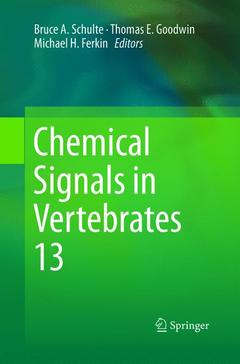Chemical Signals in Vertebrates 13, Softcover reprint of the original 1st ed. 2016
Coordonnateurs : Schulte Bruce A., Goodwin Thomas E., Ferkin Michael H.

Are Mammals Just Furry Bugs with Fewer Legs? Convergences in Mammalian and Insect Chemical Ecology.- Chemical Signals in Vertebrates 13: Where We Stand and What Might Be Next.- Assessing the Role of Olfactory Cues in the Early Life History of Coral Reef Fish: Current Methods and Future Directions.- A Small Exposé on Bovine Pheromones - with Special Reference to Modifications of the Reproductive Cycle.- Coding of Group Odor in the Subcaudal Gland Secretion of the European Badger Meles meles: Chemical Composition and Pouch Microbiota.- The Role of Bacteria in Chemical Signals of Elephant Musth: Proximate Causes and Biochemical Pathways.- Age-related Variation in the Scent Pouch Bacterial Communities of Striped Hyenas (Hyaena hyaena).- Bacterial Communities Associated with Junco Preen Glands: Preliminary Ramifications for Chemical Signaling.- Age-Related Effects on Individual Discrimination among Meadow Voles, Microtus pennsylvanicus.- Putative Pheromone of the Indian Crestless Porcupine, Hystrix brachyuran.- Chemical Cues, Hibernation and Reproduction in Female Short-Beaked Echidnas (Tachyglossus aculeatus setosus): Implications for Sexual Conflict.- Chemical Analyses Reveal Family Specific Nest Odor Profiles in Zebra Finches (Taeniopygia guttata): A Pilot Study.- Exploring the Use of Olfactory Cues in Non-Social Context in Zebra Finches (Taeniopygia guttata).- Variation in Urinary Amino Acids in the Mozambique Tilapia: A Potential Signal of Dominance or Individuality?.- A Low Phytoestrogen Diet Reduces the Proceptivity but not the Attractivity of Meadow Voles (Microtus pennsylvanicus).- Chemical communication in Indian Blackbuck (Antelope cervicapra L) with Special Reference to Dominance.- Asian Elephant Reflections: Chirality Counts.- Detection of Fish and Newt Kairomones by Ovipositing Mosquitoes.- Evolutionary Aspects of the Use of Predator Odors in Antipredator Behaviors of Lumholtz’s Tree-kangaroos (Dendrolagus lumholtzi).- Small Emissions with Major Consequences: Specialized Malodorous Defenses in Birds.- A Review of Chemical Defense in Poison Frogs (Dendrobatidae): Ecology, Pharmacokinetics and Autoresistance.- Semiochemicals in Anurans: Testing different Categories with one Poison Frog Species.- Chemical Communication in Archaic New Zealand Frogs.- Chemical Signals in Giant Panda Urine (Ailuropoda melanoleuca).- Semiochemical Communication in Dogs in the Context of Reproductive Behavior.- Hormonal and Behavioral Responses to Odor Cues in Zoo-housed African Painted Dogs (Lycaon pictus).- Responses to Domestic Cat Chemical Signals in the House Mouse are Modulated by Early Olfactory Experience.- Does Deconvolution Help to Disentangle the Complexities of Mammal Odors?.- Guidelines for Collecting and Extracting Avian Odors in a Remote Field: Case Study of a Subantarctic Seabird.- Pair-specific Scents in African Wild Dogs, Lycaon pictus, and an Example of a Potential Method to Identify Signals within Complex Mixtures.- Automated headspace solid-phase microextraction of urinary VOCs from eleven maned wolves (Chrysocyon brachyurus): a recursive workflow for GC-MS analysis.- Learning and Applications of Chemical Signals in Vertebrates for Human-Wildlife Conflict Mitigation.- An Experimental Test of the Effect of Diet on Preen Wax Composition in New Zealand Silvereyes (Zosterops lateralis).
Date de parution : 03-2019
Ouvrage de 536 p.
15.5x23.5 cm
Date de parution : 12-2015
Ouvrage de 536 p.
15.5x23.5 cm



